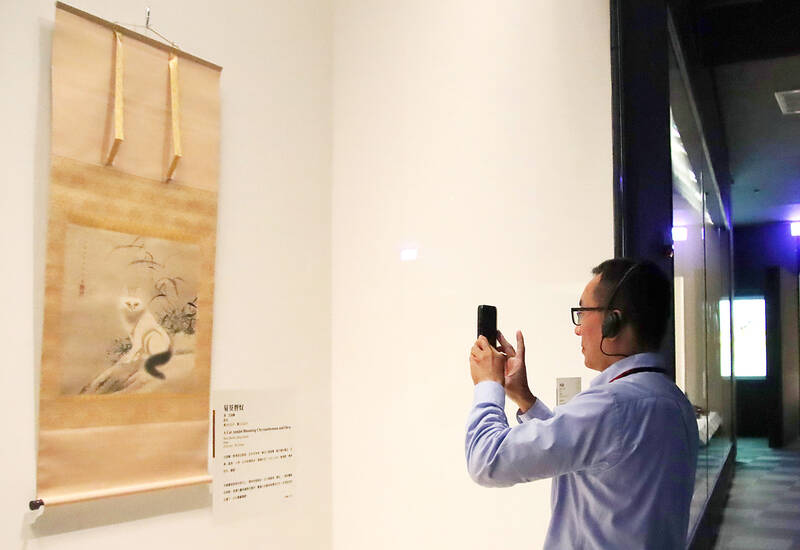The National Palace Museum’s Southern Branch yesterday opened a special exhibition featuring artwork from or linked to Okinawa’s historical Ryukyu Kingdom, including a celebrated ink brush cat painting.
The exhibition is to display 154 Okinawan artifacts, including three cultural properties of Japan and 11 prefectural or municipal-level heritage objects on loan, museum deputy director Yu Pei-chin (余佩瑾) said.
The Ryukyu Kingdom, also known as the “bridge to 10,000 nations,” was a hub of maritime trade and cultural exchange for many centuries, connecting Taiwan, China, Japan, Korea and Southeast Asia, the museum said.

Photo: Lin Yi-chang, Taipei Times
About half of the exhibition’s displays are art objects from China’s Ming (1368 to 1644) and Qing (1644 to 1911) dynasties associated with Okinawa, it said.
They include a high-stemmed lidded bowl in gold glaze from the Qing Dynasty’s imperial workshop, an identical version of which can be found in the Yomei Bunko historical archive in Kyoto, it said, adding that the latter was gifted to Ryukyu by the Qing Yongzheng Emperor.
One of the Japanese cultural properties is a three-lugged ceramic vessel with a tricolor glaze of green, blue and brown on the external and interior surfaces, a technique suggestive of Chinese influence, it said.
A red winter tunic embroidered with dragons and a yellow winter tunic embroidered with diamonds — both signifying royal power — are the some of the Japanese cultural properties expected to be displayed later, it said.
The exhibits also include six Okinawa prefectural cultural properties and five Urasoe municipal cultural properties, including the Divine Cat by Ryukyu court painter Soki Yamaguchi, the museum said.
Yamaguchi’s artworks showcase superb lining techniques, subtle colors and vivid expressions of a cat’s gaze and suppleness, marking it as a masterpiece of 18th-century Ryukyu art, the museum cited Naha City Museum of History researcher Yu Suzuki as saying.
This painting is a perennial favorite of cat lovers visiting Okinawa, she added.
The exhibit would be divided into three sections to contextualize Okinawa’s history and culture, the branch’s deputy director and curator Cheng Wing-cheong (鄭永昌) said.
Okinawa’s geography and customs would be showcased in a section featuring maps from the 15th to 18th centuries that depict the extent of the Ryukyu Kingdom’s territory, he said.
Another section is dedicated to Okinawa’s maritime ties with East Asia, with special attention to the Ryukyu Kingdom’s relations with Taiwan, imperial China and shogunate Japan through the ages, Cheng said.
A final section covers the spread of material culture and art, with focus on the kingdom’s outward-looking foreign and trade policies that led to an embrace of diverse influences in culture, art and craftsmanship, he said.
The special exhibition on the Ryukyu Kingdom is to run until Dec. 1, with companion academic conferences on Oct. 4 and Oct. 5, the museum said.

An essay competition jointly organized by a local writing society and a publisher affiliated with the Chinese Communist Party (CCP) might have contravened the Act Governing Relations Between the People of the Taiwan Area and the Mainland Area (臺灣地區與大陸地區人民關係條例), the Mainland Affairs Council (MAC) said on Thursday. “In this case, the partner organization is clearly an agency under the CCP’s Fujian Provincial Committee,” MAC Deputy Minister and spokesperson Liang Wen-chieh (梁文傑) said at a news briefing in Taipei. “It also involves bringing Taiwanese students to China with all-expenses-paid arrangements to attend award ceremonies and camps,” Liang said. Those two “characteristics” are typically sufficient

A magnitude 5.9 earthquake that struck about 33km off the coast of Hualien City was the "main shock" in a series of quakes in the area, with aftershocks expected over the next three days, the Central Weather Administration (CWA) said yesterday. Prior to the magnitude 5.9 quake shaking most of Taiwan at 6:53pm yesterday, six other earthquakes stronger than a magnitude of 4, starting with a magnitude 5.5 quake at 6:09pm, occurred in the area. CWA Seismological Center Director Wu Chien-fu (吳健富) confirmed that the quakes were all part of the same series and that the magnitude 5.5 temblor was

The brilliant blue waters, thick foliage and bucolic atmosphere on this seemingly idyllic archipelago deep in the Pacific Ocean belie the key role it now plays in a titanic geopolitical struggle. Palau is again on the front line as China, and the US and its allies prepare their forces in an intensifying contest for control over the Asia-Pacific region. The democratic nation of just 17,000 people hosts US-controlled airstrips and soon-to-be-completed radar installations that the US military describes as “critical” to monitoring vast swathes of water and airspace. It is also a key piece of the second island chain, a string of

The Central Weather Administration has issued a heat alert for southeastern Taiwan, warning of temperatures as high as 36°C today, while alerting some coastal areas of strong winds later in the day. Kaohsiung’s Neimen District (內門) and Pingtung County’s Neipu Township (內埔) are under an orange heat alert, which warns of temperatures as high as 36°C for three consecutive days, the CWA said, citing southwest winds. The heat would also extend to Tainan’s Nansi (楠西) and Yujing (玉井) districts, as well as Pingtung’s Gaoshu (高樹), Yanpu (鹽埔) and Majia (瑪家) townships, it said, forecasting highs of up to 36°C in those areas